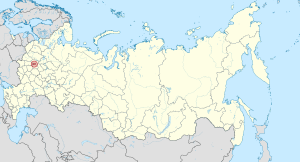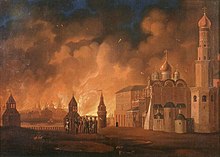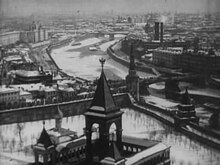Moscow
From Wikipedia, the free encyclopedia
This article is about the capital of Russia. For other uses, see Moscow (disambiguation).
"Moscow City" redirects here. For the commercial district in central Moscow, see Moscow International Business Center.
| Moscow Москва (Russian) | |||
|---|---|---|---|
| — Federal city — | |||
Top: St. Basil's Cathedral and Spasskaya Clocktower at the Red Square Center: Radisson Royal Hotel, Moscow, Bolshoi Theatre,Cathedral of Christ the Saviour, Poklonnaya Hill, Moscow Monorail, Kolomenskoye Bottom: Moscow International Business Center | |||
| |||
| Political status | |||
| Country | |||
| Federal district | Central[1] | ||
| Economic region | Central[2] | ||
| Established | Before 1147[3] | ||
| Federal city Day | The first Saturday and Sunday of September[4] | ||
| Government (as of July 2014) | |||
| - Mayor[5] | Sergey Sobyanin[5] | ||
| - Legislature | City Duma[6] | ||
| Statistics | |||
| Area [7] | |||
| - Total | 2,511 km2 (970 sq mi) | ||
| Area rank | 83rd | ||
| Population (2010 Census)[8] | |||
| - Total | 11,503,501 | ||
| - Rank | 1st | ||
| - Density[9] | 4,581.24 /km2 (11,865.4 /sq mi) | ||
| - Urban | 100% | ||
| - Rural | 0 | ||
| Population (2014 est.) | |||
| - Total | 12,108,257[10] | ||
| Time zone(s) | MSK (UTC+04:00)[11] | ||
| ISO 3166-2 | RU-MOW | ||
| License plates | 77, 99, 97, 177, 199, 197, 777, 799, 797 | ||
| Official languages | Russian[12] | ||
| Official website | |||
Moscow (/ˈmɒskaʊ/ or /ˈmɒskoʊ/; Russian: Москва, tr. Moskva; IPA: [mɐˈskva] ( )) is the capital city and the most populous federal subject of Russia. The city is a major political, economic, cultural and scientific center in Russia and in Eastern Europe. According to Forbes 2013,[13] Moscow has the largest number ofbillionaire residents in the world, has been ranked as the second most expensive city in the world by Mercer and is one of the world's largest urban economies, being ranked as an alpha global city according to the Globalization and World Cities Research Network and is also one of the fastest growing tourist destinations in the world according to the MasterCard Global Destination Cities Index. Moscow is the northernmost and coldest megacity and metropolis on Earth, the second most populous city in Europe after Istanbul[14] and the 8th largest city proper in the world, as well as the largest amongst high income economies. It is home to the Ostankino Tower the tallest free standing structure in Europe, Mercury City Tower, the tallest skyscraper in Europe and the Moscow International Business Center. It is the largest city in Russia, with a population of 12 108 257 people (2014).[8] By its territorial expansion on 1 July 2012 southwest into the Moscow Oblast, the capital increased its area 2.5 times; from about 1,000 square kilometers (390 sq mi) up to 2,511 square kilometers (970 sq mi), and gained an additional population of 233,000 people.[15][16]
)) is the capital city and the most populous federal subject of Russia. The city is a major political, economic, cultural and scientific center in Russia and in Eastern Europe. According to Forbes 2013,[13] Moscow has the largest number ofbillionaire residents in the world, has been ranked as the second most expensive city in the world by Mercer and is one of the world's largest urban economies, being ranked as an alpha global city according to the Globalization and World Cities Research Network and is also one of the fastest growing tourist destinations in the world according to the MasterCard Global Destination Cities Index. Moscow is the northernmost and coldest megacity and metropolis on Earth, the second most populous city in Europe after Istanbul[14] and the 8th largest city proper in the world, as well as the largest amongst high income economies. It is home to the Ostankino Tower the tallest free standing structure in Europe, Mercury City Tower, the tallest skyscraper in Europe and the Moscow International Business Center. It is the largest city in Russia, with a population of 12 108 257 people (2014).[8] By its territorial expansion on 1 July 2012 southwest into the Moscow Oblast, the capital increased its area 2.5 times; from about 1,000 square kilometers (390 sq mi) up to 2,511 square kilometers (970 sq mi), and gained an additional population of 233,000 people.[15][16]
Moscow is situated on the Moskva River in the Central Federal District of European Russia making it the world's most populated inland city. The city is well known for its unique architecture which consists of many different historic buildings such as Saint Basil's Cathedral with its brightly colored domes. With over 40 percent of its territory covered by greenery, it is one of the greenest capitals and major cities in Europe and the world, having the largest forest in an urban area within its borders—more than any other major city—even before its expansion in 2012. In the course of its history the city has served as the capital of a progression of states, from the medieval Grand Duchy of Moscow and the subsequent Tsardom of Russia to the Soviet Union. Moscow is considered the center of Russian culture, having served as the home of prestigious Russian artists, scientists and sports figures during the course of its history and because of the presence of many different museums, academic and political institutions and theaters. Moscow is also the seat of power of the Government of Russia, being the site of theMoscow Kremlin, a medieval city-fortress that is today the residence of the Russian president. The Moscow Kremlin and the Red Square are also one of severalWorld Heritage Sites in the city. Both chambers of the Russian parliament (the State Duma and the Federation Council) also sit in within the city.
The city is served by an extensive transit network, which includes four international airports, nine railway terminals, numerous trams, a monorail system and one of the deepest underground metro systems in the world, the Moscow Metro, fourth largest in the world and largest outside of Asia in terms of passenger numbers. It is recognized as one of the city's landmarks due to the rich and varied architecture of its 194 stations.
Over time, Moscow has acquired a number of epithets, most referring to its size and preeminent status within the nation: The Third Rome (Третий Рим), The Whitestone One (Белокаменная), The First Throne (Первопрестольная), The Forty Forties (Сорок Сороков), and The Hero City (город-герой). In old Russian the word "Сорок" (forty) also meant a church administrative district, which consisted of about forty churches. The demonym for a Moscow resident is "москвич" (moskvich), rendered in English as Muscovite.
Contents
[hide]History[edit]
Main article: History of Moscow
See also: Timeline of Moscow history
The city is named after the river (old Russian: гра́д Моско́в, literally "the city by the Moskva River"). The first reference to Moscow dates from 1147 when Yuri Dolgorukiy called upon the prince of the Novgorod-Severski to "come to me, brother, to Moscow".[3]
Nine years later, in 1156, Prince Yuri Dolgorukiy of Rostov ordered the construction of a wooden wall, the Kremlin, which had to be rebuilt multiple times, to surround the emerging city.[17] After the sacking of 1237–1238, when the Mongols burned the city to the ground and killed its inhabitants, Moscow recovered and became the capital of the independent Vladimir-Suzdal principality in 1327.[18] Its favorable position on the headwaters of the Volga River contributed to steady expansion. Moscow developed into a stable and prosperous principality (known as the Grand Duchy of Moscow) for many years and attracted a large number of refugees from across Russia.
Under Ivan I of Moscow the city replaced Tver as a political center of Vladimir-Suzdal and became the sole collector of taxes for the Mongol-Tatar rulers. By paying high tribute, Ivan won an important concession from the Khan. Unlike other principalities, Moscow was not divided among his sons, but was passed intact to his eldest. Moscow's opposition against foreign domination grew. In 1380, prince Dmitry Donskoy of Moscow led a united Russian army to an important victory over the Tatars in the Battle of Kulikovo. The battle, however, was not decisive and only two years later Moscow was sacked by khan Tokhtamysh. Ivan III, in 1480, finally broke the Russian people free from Tatar control, allowing Moscow to become the center of power in Russia.[19] Under Ivan III the city became the capital of an empire that would eventually encompass all of present-day Russia and other lands.
In 1609, the Swedish Army led by Count Jacob De la Gardie and Evert Horn started their march from Great Novgorod toward Moscow to help Tsar Vasili Shuiski, entered Moscow in 1610 and suppressed the rebellion against the Tsar, but left it early in 1611, following which the Polish–Lithuanian army invaded. During the Polish–Muscovite War (1605–1618) hetman Stanisław Żółkiewski entered Moscow after defeating the Russians in the Battle of Klushino. The 17th century was rich in popular risings, such as theliberation of Moscow from the Polish–Lithuanian invaders (1612), the Salt Riot (1648), the Copper Riot (1662), and the Moscow Uprising of 1682. The plague epidemics ravaged Moscow in 1570–1571, 1592 and 1654–1656.[21] The city ceased to be Russia’s capital in 1712, after the founding of Saint Petersburg by Peter the Great near theBaltic coast in 1703. The Plague of 1771 was the last massive outbreak of plague in central Russia, claiming up to 100,000 lives in Moscow alone. During the French invasion of Russia in 1812, the Muscovites burned the city and evacuated, as Napoleon’s forces were approaching on 14 September. Napoleon’s Grande Armée, plagued by hunger, cold and poor supply lines, was forced to retreat and was nearly annihilated by the devastating Russian winter and sporadic attacks by Russian military forces. As many as 400,000 died during this time, and only a few tens of thousands of troops returned.[22]
In January 1905, the institution of the City Governor, or Mayor, was officially introduced in Moscow, and Alexander Adrianov became Moscow’s first official mayor. Following theRussian Revolution of 1917, on 12 March 1918[23] Moscow became the capital of the Russian Soviet Federative Socialist Republic and of the Soviet Union less than five years later.[24] During World War II (the period from 22 June 1941, to 9 May 1945, known in Russia as the Great Patriotic War), after the German invasion of the USSR, the SovietState Defense Committee and the General Staff of the Red Army was located in Moscow.
In 1941, sixteen divisions of the national volunteers (more than 160,000 people), twenty-five battalions (18,500 people) and four engineering regiments were formed among the Muscovites. That November, the German Army Group Center was stopped at the outskirts of the city and then driven off in the Battle of Moscow. Many factories were evacuated, together with most of the government, and from 20 October the city was declared to be under siege. Its remaining inhabitants built and supervised antitank defenses, while the city was subjected to air bombing. Joseph Stalin refused to leave Moscow, meaning that the general staff and the council of people's commissars remained in the city as well. Despite the siege and the bombings, the construction of Moscow's metro system continued through the war, and by the end of the war several new metro lines were opened.
Estimates of casualties for the Battle of Moscow range from 248,000 to 400,000 for the Germans and from 650,000 to 1,280,000 for the Soviet Union.[25][26][27]
On 1 May 1944, a medal For the defense of Moscow and in 1947 another medal In memory of the 800th anniversary of Moscow were introduced. In commemoration of the 20th anniversary of the victory over Nazi Germany, on 8 May 1965, Moscow became one of twelve Soviet cities awarded the Hero City title.
In 1980, it hosted the Summer Olympic Games, which were boycotted by the United States and several other Western countries due to the Soviet Union's involvement in Afghanistan in late 1979. In 1991, Moscow was the scene of the failed coup attempt by the government members opposed to the reforms ofMikhail Gorbachev. When the USSR dissolved at the end of that year, Moscow continued as the capital of Russia.
Since then, the emergence of a market economy in Moscow has produced an explosion of Western-style retailing, services, architecture, and lifestyles. In 1998, Moscow hosted the first World Youth Games – see 1998 World Youth Games. This city hosted the 2013 World Championships in Athletics.
Geography and climate[edit]
Location[edit]
Moscow is situated on the banks of the Moskva River, which flows for just over 500 km (311 mi) through the East European Plain in central Russia. 49 bridges span the river and its canals within the city's limits. The elevation of Moscow at the All-Russia Exhibition Center (VVC), where the leading Moscow weather station is situated, is 156 m (512 ft). Teplostanskaya highland is the city's highest point at 255 metres (837 feet).[28]The width of Moscow city (not limiting MKAD) from west to east is 39.7 km (24.7 mi), and the length from north to south is 51.8 km (32.2 mi).
Time[edit]
Main article: Moscow Time
Moscow serves as the reference point for the timezone used in most of Central Russia, including Saint Petersburg. The areas operate in what is referred to in international standards as Moscow Standard Time (MSK, мск), which is 4 hours ahead of UTC, or UTC+4. Daylight saving time is no longer observed.














No comments:
Post a Comment